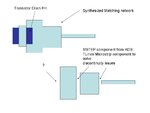adnan012
Advanced Member level 1
hi,
I am designing a n amplifier for GSM BTS. I have selected MRFE6S9125N for my design. Previously i have successfully designed GSM amplifier by using PD20015-E fro ST.
I want to use MRFE6S9125N at 30 to 40 watt output with 28v dc.
I am facing difficulties in extracting the optimum load impedance for specific output power and efficiency. I designed a prototype by using ADS MODEL of MRFE6S9125N. i Adjusted its gain at 15db from 925MHz to 960MHz by using VNA .
When i energized the amplifier by driver stage it burned at 10 watt
output power. (gate and drain both short to ground).
Is there any problem in matching network. What is the correct method of finding input and output impedance from datasheet and ads model?
Here is a document on Amplifier design. (from Very Good-Rf Power Amplifiers For Wireless Communications - Steve Cripps, Artech House,2006)
What is the significance of having load impedance high or low than optimum load impedance Ropt, as described in this chapter. i think my amplifier has been damaged by 2VDD swing.
I am designing a n amplifier for GSM BTS. I have selected MRFE6S9125N for my design. Previously i have successfully designed GSM amplifier by using PD20015-E fro ST.
I want to use MRFE6S9125N at 30 to 40 watt output with 28v dc.
I am facing difficulties in extracting the optimum load impedance for specific output power and efficiency. I designed a prototype by using ADS MODEL of MRFE6S9125N. i Adjusted its gain at 15db from 925MHz to 960MHz by using VNA .
When i energized the amplifier by driver stage it burned at 10 watt
output power. (gate and drain both short to ground).
Is there any problem in matching network. What is the correct method of finding input and output impedance from datasheet and ads model?
Here is a document on Amplifier design. (from Very Good-Rf Power Amplifiers For Wireless Communications - Steve Cripps, Artech House,2006)
What is the significance of having load impedance high or low than optimum load impedance Ropt, as described in this chapter. i think my amplifier has been damaged by 2VDD swing.
